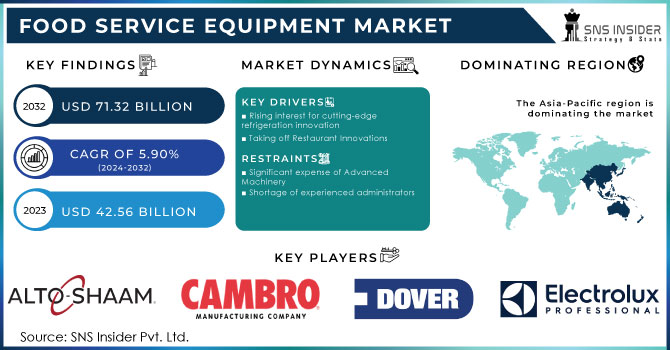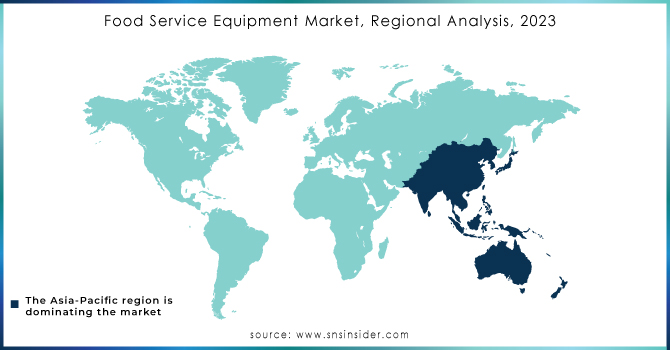Food Service Equipment Market Report Scope & Overview:

Get More Information on Food Service Equipment Market - Request Sample Report
The Food Service Equipment Market size was valued at USD 42.56 Billion in 2023 and is expected to reach USD 71.32 Billion by 2032 and grow at a CAGR of 5.90% over the forecast period of 2024-2032.
As fast help eateries become more well known, food service equipment like blenders, blenders, frozen yogurt creators, dishwashers, stoves, barbecues, and slicers are progressively being embraced.
Shrewd kitchens help to decrease waste and increment eatery effectiveness by integrating IoT and information examination into foodservice equipment as touchscreen stands, brilliant stock service frameworks, incorporated cooking equipment, and others.
In the Food Service Equipment Market, like eateries, inns, and other business kitchens, this equipment is utilized. Food Service Equipment Market Demand and Food Service Equipment Market Growth in business kitchens have been driven by the development of the cordiality business and the expanded utilization of temperature-controlled capacity equipment for short-lived and handled food varieties. Besides, the extension of the foodservice equipment market is powered by the developing requirement for multi-practical, proficient, reality saving, and decreased work. Besides, the foodservice equipment market is sectioned by topographies, central participants, and fragments.
Market Dynamics:
Driving Factors:
-
Rising interest for cutting-edge refrigeration innovation
-
Taking off Restaurant Innovations
-
Flooding Digital Innovations In Catering Industry
Restraining Factors:
-
Significant expense of Advanced Machinery
-
Shortage of experienced administrators
Opportunities:
-
Need for maintainable and harmless to the ecosystem utensils
-
Tight guidelines administering end-client well-being and growing digitization
Challenges:
-
Intricacies are associated with the utilization of specific equipment
-
High energy utilization
Impact Of COVID-19:
Disturbance in the development of the foodservice equipment market in 2020 is credited to the COVID-19 flare-up. The food service equipment industry is significantly subject to the neighborliness area for its income age. The new statement with respect to the closure of striking extent of the cordiality business, including full-service eateries, bars and bars, and fast assistance cafes has decisively hampered the offer of food service equipment.
The food service industry is zeroing in on equipment inserted with mechanized innovation. Along these lines, food service equipment producers are sending off IoT (Internet of Things) imbued new equipment and are consolidating new highlights to stay serious on the lookout. Subsequently, such factors add to the development of the food service equipment market, regarding esteem deals.
Market Estimation:
Result type, it is ordered in to cooking equipment, stockpiling and dealing with equipment, product washing equipment, food and refreshment readiness equipment and serving equipment. Ascend in ubiquity of inventive cooking and baking has brought about assortment of eat out choices for customers. Along these lines, to offer best administrations to clients, cafes put resources into various sorts of cooking equipment, which fuel the food service equipment market development.
By end use, the market is isolated into full-service eateries and inns, fast help cafés and bars, and providing food. The full-service cafes and lodgings fragment represented the most elevated food service equipment piece of the pie in the worldwide food service equipment market. Tendency of customers toward new cooking styles at sensible costs has enhanced the reception of new food service equipment advances for getting ready, putting away, and serving food sources among full-service eateries.
Key Market Segmentation:
By Product:
- Cooking Equipment
- Storage & Handling Equipment
- Warewashing Equipment
- Food & Beverage Preparation Equipment
- Serving Equipment
By End User:
-
Full-service Restaurants & Hotels
-
Quick-service Restaurants & Pubs
-
Catering
Regional Analysis:
-
North America
-
The USA
-
Canada
-
Mexico
-
-
Europe
-
Germany
-
The UK
-
France
-
Italy
-
Spain
-
The Netherlands
-
Rest of Europe
-
-
Asia-Pacific
-
Japan
-
south Korea
-
China
-
India
-
Australia
-
Rest of Asia-Pacific
-
-
The Middle East & Africa
-
Israel
-
UAE
-
South Africa
-
Rest of Middle East & Africa
-
-
Latin America
-
Brazil
-
Argentina
-
Rest of Latin America
-
Because of the developing number of foodservice focuses, rising number of family units, and changing ways of life in China and India, among other non-industrial countries, the foodservice equipment market in Asia-Pacific is anticipated to ascend at a speedy speed. Eateries are extending their menus to incorporate an assortment of foods because of a developing number of clients evaluating new suppers and fostering a preference for unusual cooking styles.
The market in Europe is anticipated to create at a surprising rate all through the estimated period, inferable from the district's roaring travel industry and a different scope of eating-out choices for customers. During the projected period, expanded urbanization is supposed to advance the development of the foodservice equipment market in the Middle East and Africa. Foodservice equipment is often used in full-service eateries for food dealing with and handling purposes. In the food service business, equipment is fundamental for cooking and serving a wide scope of food varieties.

Get Customized Report as per Your Business Requirement - Request For Customized Report
Key Players:
Alto-Shaam, Inc., Cambro Manufacturing Co. Inc., Castle Stove, Duke Manufacturing Co. Inc., Dover Corporation, Electrolux Professional, Illinois Tool Works Inc., Ali Group, Middleby Corporation, Welbilt, Inc.
| Report Attributes | Details |
|---|---|
| Market Size in 2023 | US$ 42.56 Billion |
| Market Size by 2032 | US$ 71.32 Billion |
| CAGR | CAGR 5.90% From 2024 to 2032 |
| Base Year | 2023 |
| Forecast Period | 2024-2032 |
| Historical Data | 2020-2022 |
| Report Scope & Coverage | Market Size, Segments Analysis, Competitive Landscape, Regional Analysis, DROC & SWOT Analysis, Forecast Outlook |
| Key Segments | • by Type (Food & Drink Preparation Equipment, Cooking Equipment, Heating and Holding Equipment, Storage & Handling Equipment, Ware washing Equipment) • by Application (Household, Commercial, Institutional) |
| Regional Analysis/Coverage | North America (USA, Canada, Mexico), Europe (Germany, UK, France, Italy, Spain, Netherlands, Rest of Europe), Asia-Pacific (Japan, South Korea, China, India, Australia, Rest of Asia-Pacific), The Middle East & Africa (Israel, UAE, South Africa, Rest of Middle East & Africa), Latin America (Brazil, Argentina, Rest of Latin America) |
| Company Profiles | Alto-Shaam, Inc., Cambro Manufacturing Co. Inc., Castle Stove, Duke Manufacturing Co. Inc., Dover Corporation, Electrolux Professional, Illinois Tool Works Inc., Ali Group, Middleby Corporation, Welbilt, Inc. |
| Key Drivers | •Taking off Restaurant Innovations. •Flooding Digital Innovations In Catering Industry. |
| Restraints | •Significant expense of Advanced Machinery. •Shortage of experienced administrators. |

